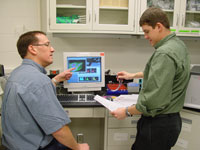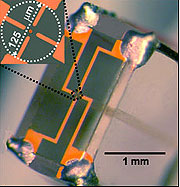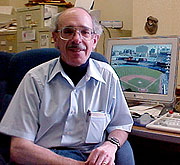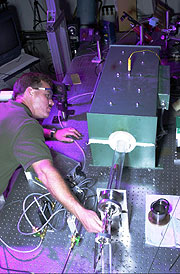Research
Highlights...
|
 |
| Number 125 |
February 3, 2003 |
|
APS detects bug 'breath'
Scientists at The Field Museum
and Argonne National Laboratory
have discovered a surprising new insect breathing mechanism that
is similar to lung ventilation in vertebrates. Insects —the
most numerous and diverse group of animals—don't have lungs.
But this study demonstrates that beetles, crickets, ants, butterflies,
cockroaches, dragonflies and other insects use rapid cycles of
tracheal compression and expansion in their head and thorax to
breathe. Up until now, it has not been possible to see movement
inside living insects. This problem has been solved by using the
Advanced Photon Source at Argonne, which produces the most brilliant
X-rays in the Western Hemisphere, to obtain videos of living,
breathing insects.
[Catherine Foster, 630/252-5580,
cfoster@anl.gov]
|
|
New antibody library
speeds search for new detection tools
 |
| PNNL
scientists Michael Feldhaus (left) and Rob Siegel (right)
developed a library of 1 billion human antibodies on brewer's
yeast in collaboration with MIT. |
Scientists at DOE's Pacific Northwest
National Laboratory have extracted part of the human immune
system and reconstituted
it in brewer's yeast in a fashion that enables identification
of new antibodies in days rather than the months it takes with
current approaches. PNNL researchers built a library of 1 billion
human antibodies and expressed them on the surface of yeast cells
using a platform designed by an MIT collaborator. The combined
technologies offer a more powerful, less expensive method for
identifying antibodies. The advance could have major repercussions
for fundamental biological science as well as industries that
use antibodies for sensors, biodetectors, diagnostic tools and
therapeutic agents. The technology could replace the need to produce
antibodies within animals, such as mice, and opens up new possibilities
for rapidly designing medical treatments more acceptable to the
human immune system.
[Staci
Maloof, 509/372-6313,
staci.maloof@pnl.gov]
|
|
Fermilab's DZero Detector
goes global
A newly-developed Global Monitoring System in operation at the DZero
particle detector at DOE's Fermi
National Accelerator Laboratory enables more
than 600 members of the experiment's world-wide collaboration to
fulfill their requirements for taking part in the detector's control
room shifts, monitoring physics data and detector performance, via
computer from their home institutions. Experimenters have been taking
control room shifts from as far away as India. Said DZero co-spokesperson
John Womersley: "Tools that have been developed to improve collaborative
work in high energy physics have turned out to be more broadly useful.
Medicine and global business are obvious examples. Our community
is international, highly networked, and closely collaborating. It
can serve as an effective 'technology incubator' for ideas like
this."
[Mike
Perricone, 630/840-5678,
mikep@fnal.gov]
|
|
Tiny device for telecommunications
 |
| Liquid
crystal device built on the tip of an optical fiber. |
Scientists have built a new device used to correct signal distortions
at high speed in optical fibers—the plastic or glass cables
used to carry high-speed signals from television, computer, telephone
and radar. The new device, which uses liquid crystals instead
of the currently used lithium niobate, could make optical communications
more affordable in the future. This research was funded by DOE
and the National Science Foundation, and was conducted by scientists
from DOE's Brookhaven National
Laboratory and at Bell Laboratories, Lucent Technologies'
Research and Development arm. The Bell Lab scientists are currently
interacting with industrial partners to manufacture and commercialize
the new device.
[Mona
S. Rowe, 631/344-5056,
mrowe@bnl.gov]
|
|
Going
to Take a Scientific Journey
 |
|
Mark
Gordon
|
I wouldn't know what to if I wasn't doing research," says Mark
Gordon, Ames Laboratory
program director of Applied Mathematics and Computational Sciences.
"I get up in the morning and go to bed at night thinking about
science."
It's good he feels that way because a Fulbright Award will
take him to the Australian
National University in Canberra for a February-through-May
science sojourn. While there, Gordon will focus on his favorite
thing quantum chemistry a branch of physical chemistry that
deals with explaining chemical phenomena by using the laws of
quantum mechanics.
In one of several research efforts, Gordon will be working
with ANU colleague Leon Radom on a new quantum chemistry method
to predict the thermodynamic properties of complex systems,
such as transition metal compounds, excited states and metastable
species. "The method works really well, but one challenge will
be to develop a clever way of extending it to much bigger chemical
systems," Gordon says.
A second undertaking will highlight Gordon's ongoing efforts
to enhance GAMESS,
a software suite that does quantum chemistry electronic structure
calculations. He will collaborate with ANU's Michael Collins
to merge Collins' GROW code with GAMESS. GROW actually grows
the potential energy surfaces for molecular systems containing
four to seven atoms. "Generating the potential energy surface
is a tremendous problem, but GROW does this automatically by
telling GAMESS the points at which an energy should be calculated,"
says Gordon.
In another project, Gordon will work with ANU colleague Alistair
Rendell to develop more parallel code for GAMESS that will be
a combination of graphics and parallel programming.
Anticipating his lengthy stay in Australia doing what he loves
best, Gordon says, "For the most part, I can think just about
science for four months. It's like getting to go to the World
Series all the time," adds the avid baseball fan.
Submitted by DOE's Ames Lab
|
|




